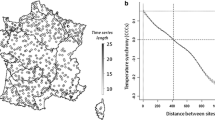Abstract
Cross-correlation analysis is the most valuable and widely used statistical tool for evaluating the strength and direction of time-lagged relationships between ecological variables. Although it is well understood that temporal autocorrelation can inflate estimates of cross correlations and cause high rates of incorrectly concluding that lags exist among time series (i.e. type I error), in this study we show that a problem we term intra-multiplicity can cause substantial bias in cross-correlation analysis even in the absence of autocorrelation. Intra-multiplicity refers to the numerous time lags examined and cross-correlation coefficients computed within a pair of time series during cross-correlation analysis. We show using Monte Carlo simulations that intra-multiplicity can spuriously inflate estimates of cross correlations by identifying incorrect time lags. Further, unlike autocorrelation, which generally identifies lags close to the true lag, intra-multiplicity can erroneously identify lags anywhere in the time series and commonly results in a direction change of the correlation (i.e. positive or negative). Using Monte Carlo simulations we develop formulas that quantify the bias introduced by intra-multiplicity as a function of sample size, true cross correlation between the series, and the number of time lags examined. A priori these formulas enable researchers to determine the sample size needed to minimize the biases introduced by intra-multiplicity. A posteriori the formulas can be used to predict the expected bias and type I error rate associated with the data at hand, as well as the maximum number of time lags that can be analyzed to minimize the effects of intra-multiplicity. We examine the relationship between commercial catch of chum salmon and surface temperatures of the North Pacific (1925–1992) to illustrate the problems of intra-multiplicity in fisheries studies and the application of our formulas. These analyses provide a more robust framework to assess the temporal relationships between ecological variables.
Similar content being viewed by others
Author information
Authors and Affiliations
Additional information
Received: 28 July 2000 / Accepted: 6 December 2000
Rights and permissions
About this article
Cite this article
Olden, J., Neff, B. Cross-correlation bias in lag analysis of aquatic time series. Marine Biology 138, 1063–1070 (2001). https://doi.org/10.1007/s002270000517
Issue Date:
DOI: https://doi.org/10.1007/s002270000517




